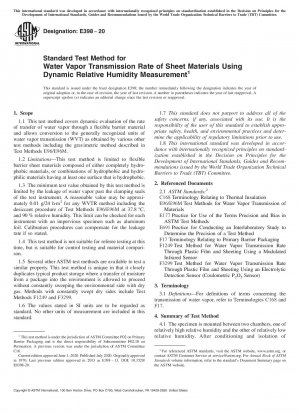ASTM E398-20
Standard Test Method for Water Vapor Transmission Rate of Sheet Materials Using Dynamic Relative Humidity Measurement
- Standard No.
- ASTM E398-20
- Release Date
- 2020
- Published By
- American Society for Testing and Materials (ASTM)
- Latest
- ASTM E398-20
- Scope
- 1.1 This test method covers dynamic evaluation of the rate of transfer of water vapor through a flexible barrier material and allows conversion to the generally recognized units of water vapor transmission (WVT) as obtained by various other test methods including the gravimetric method described in Test Methods E96/E96M. 1.2 Limitations—This test method is limited to flexible barrier sheet materials composed of either completely hydrophobic materials, or combinations of hydrophobic and hydrophilic materials having at least one surface that is hydrophobic. 1.3 The minimum test value obtained by this test method is limited by the leakage of water vapor past the clamping seals of the test instrument. A reasonable value may be approximately 0.01 g/24 h·m2 for any WVTR method including the desiccant procedure of Test Methods E96/E96M at 37.8 °C, and 90 % relative humidity. This limit can be checked for each instrument with an impervious specimen such as aluminum foil. Calibration procedures can compensate for the leakage rate if so stated. 1.4 This test method is not suitable for referee testing at this time, but is suitable for control testing and material comparison. 1.5 Several other ASTM test methods are available to test a similar property. This test method is unique in that it closely duplicates typical product storage where a transfer of moisture from a package into the environment is allowed to proceed without constantly sweeping the environmental side with dry gas. Methods with constantly swept dry sides include Test Methods F1249 and F3299. 1.6 The values stated in SI units are to be regarded as standard. No other units of measurement are included in this standard. 1.7 This standard does not purport to address all of the safety concerns, if any, associated with its use. It is the responsibility of the user of this standard to establish appropriate safety, health, and environmental practices and determine the applicability of regulatory limitations prior to use. 1.8 This international standard was developed in accordance with internationally recognized principles on standardization established in the Decision on Principles for the Development of International Standards, Guides and Recommendations issued by the World Trade Organization Technical Barriers to Trade (TBT) Committee.
ASTM E398-20 Referenced Document
- ASTM C168 Standard Terminology Relating to Thermal Insulation*, 2022-05-01 Update
- ASTM E177 Standard Practice for Use of the Terms Precision and Bias in ASTM Test Methods
- ASTM E691 Standard Practice for Conducting an Interlaboratory Study to Determine the Precision of a Test Method
- ASTM E96/E96M Standard Test Methods for Gravimetric Determination of Water Vapor Transmission Rate of Materials*, 2024-03-01 Update
- ASTM F1249 Standard Test Method for Water Vapor Transmission Rate Through Plastic Film and Sheeting Using a Modulated Infrared Sensor
- ASTM F17 Standard Terminology Relating to Flexible Barrier Materials
- ASTM F3299 Standard Test Method for Water Vapor Transmission Rate Through Plastic Film and Sheeting Using an Electrolytic Detection Sensor (Coulometric P
2 O5 Sensor)*, 2023-05-01 Update
ASTM E398-20 history
- 2020 ASTM E398-20 Standard Test Method for Water Vapor Transmission Rate of Sheet Materials Using Dynamic Relative Humidity Measurement
- 2013 ASTM E398-13 Standard Test Method for Water Vapor Transmission Rate of Sheet Materials Using Dynamic Relative Humidity Measurement
- 2003 ASTM E398-03(2009)e1 Standard Test Method for Water Vapor Transmission Rate of Sheet Materials Using Dynamic Relative Humidity Measurement
- 2003 ASTM E398-03 Standard Test Method for Water Vapor Transmission Rate of Sheet Materials Using Dynamic Relative Humidity Measurement
